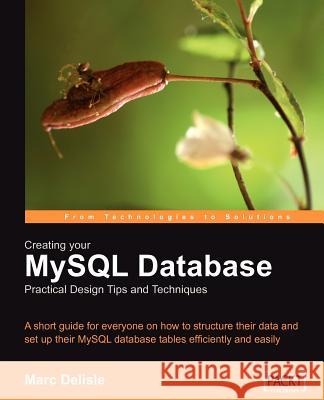Creating your MySQL Database: Practical Design Tips and Techniques » książka
Creating your MySQL Database: Practical Design Tips and Techniques
ISBN-13: 9781904811305 / Angielski / Miękka / 2006 / 108 str.
This book is an innovative and essential short guide for everyone on how to structure your data and set-up your MySQL database tables efficiently and easily. If you're creating a dynamic web application using open-source tools, then you're probably going to be setting up a MySQL database. Getting the design of this database right for your application and its data is vital, but it's often an intimidating and little-known process for non-developers and developers alike. Written by the creator of the popular phpMyAdmin tool, this book is a short but complete guide on how to design good data structures for MySQL. For most of us, setting up the database for an application is often an afterthought. While you don't need to be a professional database designer to create a working application, knowing a few insider tips and techniques can make both the process easier and the end result much more effective. This book doesn't set out to make you an expert in data analysis, but it does provide a quick and easy way to raise your game in this essential part of getting your application right. The book covers: Asking users the right questions to collect relevant data for the system you are building Detecting bad structures Sound data-naming techniques, for both table and column names Modeling data with future growth in mind Implementing security policies with data privileges and views Tuning the structure for performance Producing system documentation (data dictionary, relational schema) Testing the model with appropriate SQL queries This book takes a practical approach, implementing all theoretical concepts with examples. It is a fast-paced tutorial that focuses on critical decisions that you need to make every time you build MySQL databases. It is rich with tips and advice from an experienced practitioner. The book is ideal for anyone working with applications that use a MySQL database backend will benefit greatly from the advice and techniques in this book. Although a working knowledge of both SQL and MySQL is assumed, the book is suitable for both beginners and intermediate users alike. Whether you read it through and absorb the advice or work through it on a live project, the efficiency and maintainability of your databases will certainly improve as a result. Chapter 1: Introduction Chapter 2: Data Collection Chapter 3: Data Naming Chapter 4: Data Grouping Chapter 5: Data Structure Tuning Chapter 6: Case Study: An Airline System
This book is an innovative and essential short guide for everyone on how to structure your data and set-up your MySQL database tables efficiently and easily.If youre creating a dynamic web application using open-source tools, then youre probably going to be setting up a MySQL database. Getting the design of this database right for your application and its data is vital, but its often an intimidating and little-known process for non-developers and developers alike. Written by the creator of the popular phpMyAdmin tool, this book is a short but complete guide on how to design good data structures for MySQL.For most of us, setting up the database for an application is often an afterthought. While you dont need to be a professional database designer to create a working application, knowing a few insider tips and techniques can make both the process easier and the end result much more effective. This book doesnt set out to make you an expert in data analysis, but it does provide a quick and easy way to raise your game in this essential part of getting your application right. The book covers:Asking users the right questions to collect relevant data for the system you are buildingDetecting bad structuresSound data-naming techniques, for both table and column namesModeling data with future growth in mindImplementing security policies with data privileges and viewsTuning the structure for performanceProducing system documentation (data dictionary, relational schema)Testing the model with appropriate SQL queriesThis book takes a practical approach, implementing all theoretical concepts with examples. It is a fast-paced tutorial that focuses on critical decisions that you need to make every time you build MySQL databases. It is rich with tips and advice from an experienced practitioner. The book is ideal for anyone working with applications that use a MySQL database backend will benefit greatly from the advice and techniques in this book. Although a working knowledge of both SQL and MySQL is assumed, the book is suitable for both beginners and intermediate users alike. Whether you read it through and absorb the advice or work through it on a live project, the efficiency and maintainability of your databases will certainly improve as a result.Chapter 1: IntroductionChapter 2: Data CollectionChapter 3: Data NamingChapter 4: Data GroupingChapter 5: Data Structure TuningChapter 6: Case Study: An Airline System











